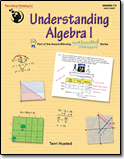
Algebra strikes terror into the hearts of many and it is one of those topics that people often do not learn well. In Understanding Algebra I Terri Husted, a recognized New York math teacher specializing in math anxiety, addresses these issues by presenting algebra clearly and systematically. In her book, as in real life, she tries to make algebra her students’ favorite subject.
Written for grades 7-9, Understanding Algebra 1 is meant to be a complete one year curriculum. It begins with technical information about our number system and an arithmetic review, then clearly explains how to solve equations, and then moves on to word problems, inequalities, and polynomials. It tackles factoring, radicals, linear functions, systems of equations, and more with just the right amount of review and with clear explanations. Fairly often math history or real world topics are included, and those are a valuable addition to any math course.
Most of the 362-page book is clear, with pages that are well-laid out and not overwhelming. Colored boxes are used to make the important ideas stand out and to separate concepts and examples. For students with average-sized handwriting there is space to do most problems in the book itself. Answers with some explanations are given in the back. Most chapters end with a review section that can be used as an evaluation or as the basis of a test. A colored reference page containing all helpful equations is given in the back of the book, and there is also a glossary.
Comparison to other curricula:
Key to Algebra includes more hands-on discovery with less explanation. Understanding Algebra 1 spells concepts out more clearly but has less practice. Both are recommended for students having difficulties or working somewhat independently.
Singapore New Elementary Math 1 and 2 are much more thorough but their problems are more difficult than those in Understanding Algebra 1. If your child is intimidated by math or just needs the basics, Understanding Algebra 1 is better; on the other hand, if your child is confident and may possibly move on to future studies involving math, the Singapore texts lay a more solid foundation.
Practical tip:
Unfortunately the first three pages of Understanding Algebra 1 are wordy and overwhelming. It’s not that the material is difficult, but it looks difficult, and for some students that is a serious problem at the beginning of a new book. Basically this first chapter is a review of set theory, of the kinds of numbers that exist, and of the rules of arithmetic. Although a standard math text may need to include set theory to meet government standards, I have never noticed set theory adding anything except a vague feeling of uncertainty to introductory algebra classes. So, as a homeschool mom, you may wish to tweak this chapter and get review material from elsewhere until you are sure your child can do the review page, and then begin actually using this book in Chapter 2.
Possible improvements in the next edition:
Put the reference page on the inside back cover, as is often done in advanced textbooks, so that it will be easier to find. Include an index. Redo the first few pages to make them inviting, not intimidating. Start each new chapter on the right hand page, leaving a blank page or two if necessary. These suggestions would improve the book, but if they are not big issues for your family, your children will probably enjoy it if they need a break from your regular math curriculum.
Would this work for your children?
For basic Algebra 1, Terri Husted’s Understanding Algebra 1 is a valuable resource with a relatively low cost. It could be used as a full curriculum, a remedial supplement, or a summer review program, and I especially recommend it if you need a basic text and want a break from your regular math curriculum. Currently you can buy Understanding Algebra 1 from the Critical Thinking Press at a 15% discount (for any size order) using the coupon code BLOGR315. For more details on this offer see below.
—
For all sorts of goodies for teaching math, visit Terri Husted’s informative math page.
—
I have also reviewed Critical Thinking Press logic resources and recommend them highly.
—
15% Off Any Size Order from Critical Thinking Press!
Details: Offer expires 5/31/2015 at Midnight PST. Use Coupon Code BLOGR315. Online prepaid orders only. Valid one per customer. Offer does not apply to iOS or Android apps, or manipulatives such as Attribute Blocks, Interlocking Cubes or Pattern Blocks. Offer may not be combined with other discounts or offers, and is not retroactive. Not valid on wholesale orders.
—
This review is linked to Finishing Strong, Trivium Tuesdays, Raising Homemakers, R&R Wednesdays, and Titus 2 Tuesday.
Disclosure: I received a free review copy of this book and have expressed my own opinions.




